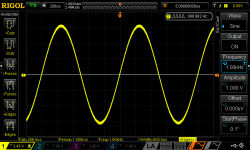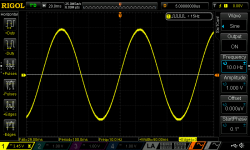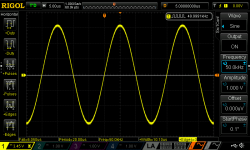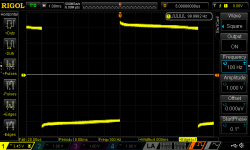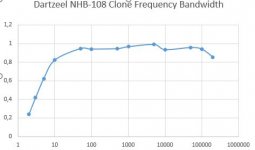I wouldn't worry too much N101N. 😇
It is impossible to be of-context in a thread that entirely went of-topic. This is a NHB-108 conversation and you are certainly still on-topic.
No ofense meant to anyone, just a benevolent reminder.
It is impossible to be of-context in a thread that entirely went of-topic. This is a NHB-108 conversation and you are certainly still on-topic.
No ofense meant to anyone, just a benevolent reminder.
Today I have made several measurements of the amplifier based on Chinese NHB-108 board populated with components from reputable source. I have used good +/-25 VDC power supply.
I have attached snapshots of several measurements. Measurements indicate that the amplifier has adequate frequency response over the range between 5Hz and 50KHz. Falling slope of response to 100 Hz 1V square wave indicates moderate low frequency attenuation.
Hooked to speakers amplifier creates virtually no buzz, whine, hiss, chatter, or any noises. The amplifier is dead-silent. So silent that I was affraid that it doesn't work at all.😱😀 (Just kidding - Meanwhile I have learned how to make an adequate power supply)
Cheers and pleasant weekend dear friends.
I have attached snapshots of several measurements. Measurements indicate that the amplifier has adequate frequency response over the range between 5Hz and 50KHz. Falling slope of response to 100 Hz 1V square wave indicates moderate low frequency attenuation.
Hooked to speakers amplifier creates virtually no buzz, whine, hiss, chatter, or any noises. The amplifier is dead-silent. So silent that I was affraid that it doesn't work at all.😱😀 (Just kidding - Meanwhile I have learned how to make an adequate power supply)
Cheers and pleasant weekend dear friends.

Attachments
Last edited:
What voltage amplifying stages typically suffer from is a shortage of bandwidth. Driving heavier loads requires larger amplitudes, conveying higher currents, higher frequency, higher instability and a shrinking bandwidth. On the other hand, voltage followers do not produce large amplitudes, resulting in signal loss, poor dynamics and dull performance.
The 458 circuit is quite OK, no unnecessary stages, but I would make some modifications. This kind of PA-style amplifiers will necessarily exhibit high distortion. Setting adequate bias currents without severe thermal abuse is difficult.
The 458 circuit is quite OK, no unnecessary stages, but I would make some modifications. This kind of PA-style amplifiers will necessarily exhibit high distortion. Setting adequate bias currents without severe thermal abuse is difficult.
Thanks N101N
Thanks N101N,
I intend to use one, perhaps two NHB-108 for tri-amping - for tweeter and midrange woofer. Krell KSA-50 will be hooked to subwoofer. Perhaps in this configuration NHB-108 will do the job adequately.
I have a 97dB woofer and I had no problems, quite the contrary: I like sound detail and spatial impression provided by the NHB-108 because I prefer classical/acoustic music.
Perhaps, in the future I change my mind and replace 108 with 458.
Can you imagine this: I have built a system with quasi $50G value with a little help from my friends 🙂.
🙂.
Thanks N101N,
I intend to use one, perhaps two NHB-108 for tri-amping - for tweeter and midrange woofer. Krell KSA-50 will be hooked to subwoofer. Perhaps in this configuration NHB-108 will do the job adequately.
I have a 97dB woofer and I had no problems, quite the contrary: I like sound detail and spatial impression provided by the NHB-108 because I prefer classical/acoustic music.
Perhaps, in the future I change my mind and replace 108 with 458.
Can you imagine this: I have built a system with quasi $50G value with a little help from my friends
 🙂.
🙂.Today I have made several measurements of the amplifier based on Chinese NHB-108 board populated with components from reputable source. I have used good +/-25 VDC power supply.
I have attached snapshots of several measurements. Measurements indicate that the amplifier has adequate frequency response over the range between 5Hz and 50KHz. Falling slope of response to 100 Hz 1V square wave indicates moderate low frequency attenuation.
Hooked to speakers amplifier creates virtually no buzz, whine, hiss, chatter, or any noises. The amplifier is dead-silent. So silent that I was affraid that it doesn't work at all.😱😀 (Just kidding - Meanwhile I have learned how to make an adequate power supply)
Cheers and pleasant weekend dear friends.
How much PSU capacitance did u use? I upgraded from 20kuF per chanel to 54kuF, I feel it’s quieter, and bass is tighter.
Contrary to widely spread gospel that one needs large beer-can size 100V rated capacitors, I have decided to addopt a bit smarter design: 6X10.000uF per chanel but I have used configuration shown in this article:
Solid State Power Amplifier Supply Part 3
The article consists of three parts: read them all, it pays of. The third part describes power supply in detail.
These 100uf+100pF capacitors + RF and RC network consisting of 1 Ohm/17W in series with 680nF did the job.
Good luck 🙂
PS: The article indicates but does not stress enough importance of installing the last stage of the power supply as close as possible to the output stage, even if that means you have to separate the last stage from the power supply and install it closer to the power amplifier board.
Solid State Power Amplifier Supply Part 3
The article consists of three parts: read them all, it pays of. The third part describes power supply in detail.
These 100uf+100pF capacitors + RF and RC network consisting of 1 Ohm/17W in series with 680nF did the job.
Good luck 🙂
PS: The article indicates but does not stress enough importance of installing the last stage of the power supply as close as possible to the output stage, even if that means you have to separate the last stage from the power supply and install it closer to the power amplifier board.
Last edited:
Very good.
Erlend 😎
I'm glad to hear that after all these difficulties you've succeeeded. It appears that this amplifier is really good choice with lots of potential, despite some criticism.
Right now I'm building a system based on the use of active crossovers to extract even more good sound from it. I'll keep you informed about the progress of my work. 🙂
Paroxod 🙂
Always glad to hear from you. A company of great guys has gathered arround here.
Erlend 😎
I'm glad to hear that after all these difficulties you've succeeeded. It appears that this amplifier is really good choice with lots of potential, despite some criticism.
Right now I'm building a system based on the use of active crossovers to extract even more good sound from it. I'll keep you informed about the progress of my work. 🙂
Paroxod 🙂
Always glad to hear from you. A company of great guys has gathered arround here.
Hi Erlend, again!I use a servo but my Dartzeel sounds awesome now. Can not see probleme with the servo.
Could you please tell us more what you have done to solve the problems. If memory stil serves me, your difficulties were rather hard.
Your info may be helpful to others who possibly face similar hurdles.
Thanks in advance and have a pleasant weekend.🙂
Berlusconi Greetings, I have read all 3 parts of the article on the power supply, it is not clear how to correctly measure the idle speed of the transformer. On one Russian forum it sounds like this. To measure XX trance current, you need to in series in the primary winding circuit! connect a 1 ohm resistor, and measure an alternating voltage on its legs, then divide this voltage by 1, this will be the XX current of the transformer, the secondary windings of course should not be connected. The more accurate the resistor, the more accurate the measurement, respectively. Only neatly 220V !!!With such measurements, my transformers are shown on the tester, when connected to the network 4-5mA, after 15-30 seconds 7-8mA. Are the measurements correct?😕
Hi Erlend, again!
Could you please tell us more what you have done to solve the problems. If memory stil serves me, your difficulties were rather hard.
Your info may be helpful to others who possibly face similar hurdles.
Thanks in advance and have a pleasant weekend.🙂
Servo fixed the DC problem. Totally seperate Gnd for the two channels supply fixed the hum problem. R 101 and r 102 is 51 kohm. Input impedance is 20 kohm Vishay 102. Now it's really a good amp. Yes much tube alike but ok control in bass. I love it. Suddenly I also like classical music. Didn't use to😁
Hello Paroxod,Berlusconi Greetings, I have read all 3 parts of the article on the power supply, it is not clear how to correctly measure the idle speed of the transformer. On one Russian forum it sounds like this. To measure XX trance current, you need to in series in the primary winding circuit! connect a 1 ohm resistor, and measure an alternating voltage on its legs, then divide this voltage by 1, this will be the XX current of the transformer, the secondary windings of course should not be connected. The more accurate the resistor, the more accurate the measurement, respectively. Only neatly 220V !!!With such measurements, my transformers are shown on the tester, when connected to the network 4-5mA, after 15-30 seconds 7-8mA. Are the measurements correct?😕
Meassurements are correct. You should realise that the current changes in are in accordance with the power requiered by the amplifier. For the AB amplifier even more so because AB class amplifier has relatively low quiecescent power and signifficant current transients which depend on the music you listen to. It appears that for AB class amplifier the design of power supply is even much more important than to the class A with constant and high amperage with relativel lower fluctuations. Power supply must be able to accomodate to sudden signifficant and instantenious changes of the current requiered by the amplifier. It appears that the design of power supply is at least as much important as the design of the amplifier. They have to be connected via the shortest wires possible. Interestingly, the "Russian" Dartzeel addresses this problem - it has extra capacitors on-board, that's good. Today I have ordered five Russian PCBs to test them. I am confident to have even better results. Later on I will post measurements of the amplifier performance before and after the power supply modifications.
The DartZeel clone is a great amplifier.

Have a pleasant Sunday afternoon.
Thanks Erlend,Servo fixed the DC problem. Totally seperate Gnd for the two channels supply fixed the hum problem. R 101 and r 102 is 51 kohm. Input impedance is 20 kohm Vishay 102. Now it's really a good amp. Yes much tube alike but ok control in bass. I love it. Suddenly I also like classical music. Didn't use to😁
I will attempt to use your suggestions to further improove the sound. Thanks for the values of individual resistors, that's really helpful. I am also working on tri-amping with the use of active crossovers. I expect this would improove the sound by separating signal and then using adequate amplifiers for different frequency ranges. I will need several weeks to complete this relatively complex modification. Nevertheless, I will keep you informed on the progress.
Enjoy the music. May I recomend you Brandenburg Concertos by Bach. They are indeed fine stuff for new-commers and, by the way, you may test the detail because there are not many instruments involved in chamber orchestra so you can identify every instrument in space, from left to right and identify possible problems.

Berlusconi , Thanks for the answer. So I have good Chinese toroidal transformers for Dartzeel. :Д
Paroxod: Winter is comming and you should switch to Krell KSA-50 because you live at the Arctic circle (Arkhangelsk) You need a 1KW stove instead,
Seriously now: there was a word about the frequency bandwidth and Dartzeel has a plenty of it. Even at 200 KHz it doesn't even show signs of roll-of. At the other extreme, the cut-of frequency is at about 5 Hz.
Below you can see the results with the use of +/-42 rails into a pair of 22R 100W resistors in parallel. Just observe how it delievers plenty of power at 200KHz, more than 10 times beyond the audible region.
Seriously now: there was a word about the frequency bandwidth and Dartzeel has a plenty of it. Even at 200 KHz it doesn't even show signs of roll-of. At the other extreme, the cut-of frequency is at about 5 Hz.
Below you can see the results with the use of +/-42 rails into a pair of 22R 100W resistors in parallel. Just observe how it delievers plenty of power at 200KHz, more than 10 times beyond the audible region.
Attachments
Last edited:
@Erlend
Ah, I understand - the graph is in logaritmic scale, for clarity. Hence the impression of signifficant rise. Observe, that the distance from 1 to 10Hz equals to that from 10 to 100 Hz. Logaritmic scale provides more resolution at the lower part hence making possible to show data over the wide range from 1 up to 1.000.000 Hz.
I think 5 Hz cutof is not so early, it's a normal and expected behaviour. If we go up to to the audible region, the roll-of is insignifficant. Normal electrical bass guitar has the lowest tone 41Hz, only the pipe organ goes close to 20Hz. Harpiscord goes slightly below 30Hz. Of course, there are inaudiable frequencies that we "hear" as the sound pressure but, still 5 Hz cutoff is fine to me. During the measurements I've "heard" inaudible frequencies as objects vibrating on my bench - not the sound but these object just jumped as the vibrations have moved them.
Ah, I understand - the graph is in logaritmic scale, for clarity. Hence the impression of signifficant rise. Observe, that the distance from 1 to 10Hz equals to that from 10 to 100 Hz. Logaritmic scale provides more resolution at the lower part hence making possible to show data over the wide range from 1 up to 1.000.000 Hz.
I think 5 Hz cutof is not so early, it's a normal and expected behaviour. If we go up to to the audible region, the roll-of is insignifficant. Normal electrical bass guitar has the lowest tone 41Hz, only the pipe organ goes close to 20Hz. Harpiscord goes slightly below 30Hz. Of course, there are inaudiable frequencies that we "hear" as the sound pressure but, still 5 Hz cutoff is fine to me. During the measurements I've "heard" inaudible frequencies as objects vibrating on my bench - not the sound but these object just jumped as the vibrations have moved them.
Last edited:
Thanks but I have been told 0.5 Hz is to be preferred for the reason off the attack in bass. And roll off starts 10 times higher then the -3 dB point. Anyway does the servo also harm the attack. All in in all I think the amp is really good now. I use 47 uf bipolar as series capacitor at input. Looking forward to your review off the amp when you Finnish it.
Last edited:
- Home
- Amplifiers
- Solid State
- Dartzeel amp schematic - build this?
